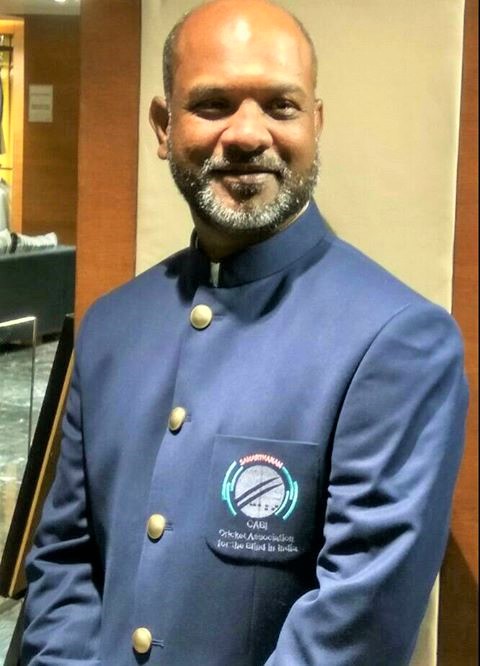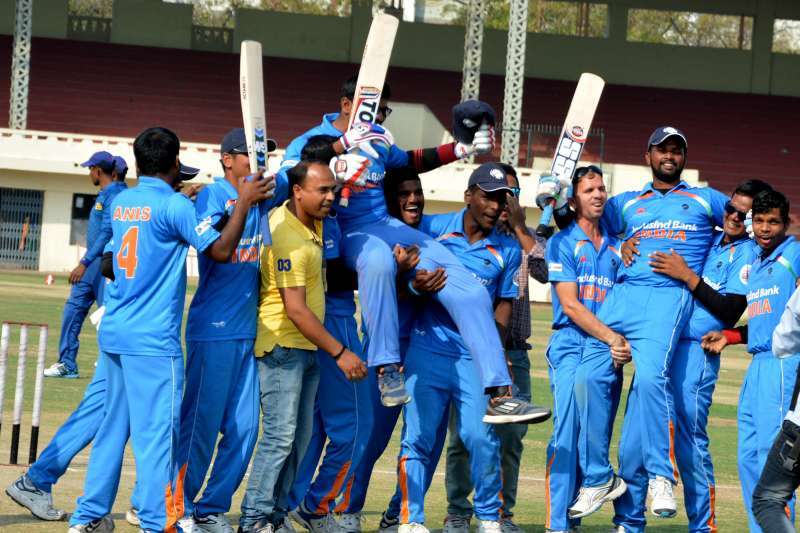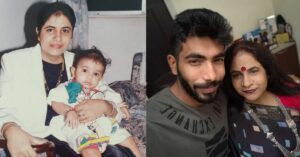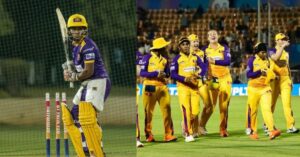This Political Science Professor Has Led the Indian Blind Cricket Team to Three World Cup Wins!
Last month, the Indian Blind Cricket team lifted the T20 World Cup for Blind title for the second time in a row. And it was not a career sportsman but a determined college professor who led this talented team to the top spot.

In a nation where cricket is a religion, there is a team that plays the gentleman’s game and yet feels the nation has turned a blind eye towards it.
Last month, the Indian Blind Cricket team defeated Pakistan by nine wickets to lift the T20 World Cup for Blind title for the second time in a row. And it was a political science professor who led this talented team to the top spot.
Neither a career coach nor a career sportsman, Patrick Rajkumar has been coaching India’s Blind Cricket team since 2012. Under him, the team has won the T20 World Cup, the Asia Cup and the ODI World Cup!

Born and brought up in a small village in Kolar Gold Field region of Karnataka, Patrick came to Bengaluru to pursue his graduation at St Joseph’s College, an alma mater he shares with Rahul Dravid. A sports lover, he used to play a lot during his college days. His favourite sports were table tennis and football, with cricket being a distant third.
However, after he graduated and started working as a political science professor, he gradually lost touch with sports. Other than being a professor, Patrick was also a life skills coach and trained counsellor who worked with youth groups. So, when he was offered the job of coaching the blind cricket team by Cricket Association of the Blind in India (CABI), he was just as apprehensive as he was eager.
Patrick knew that CABI had approached him more for his man management skills than his cricketing ones. Ever since the Indian team’s dismal show at the 40-over ODI World Cup in 2006 (won by Pakistan), blind cricket in India had been in the doldrums. Changing this status quo would require a special effort and Patrick knew it.
“The first thing I did was a detailed research into the sport. I read articles, saw videos, basically understood what was required of me. This was when I realised that the job would be tough and full of challenges, but not impossible. And if I succeeded, I would be helping the players fulfill a long-cherished dream. So, I accepted,” says Patrick.

Patrick Rajkumar
Patrick’s first and most important challenge was getting the players to trust him and believe that he was fit for the job. Having never played blind cricket, most of the team members initially felt that Patrick would not be able to fit in their world or understand their problems.
Undeterred by their wariness and scepticism, Patrick began working slowly but consistently to transform them from players to champions. The T20 World Cup was two months away and his first step was to implement a regimental training system for the players.
The players’ day would begin with them hitting the training ground at 5.30 am everyday. This was followed by six to seven hours of focussed training in an undisturbed environment. He also designed a carefully-researched diet chart and exercise schedule for them. The players initially found Patrick’s schedule tough but they adapted to it soon.
Patrick’s next step was dividing the training sessions so as to focus on both physical and mental preparedness of the players. While players focussed on physical fitness and cricket skills in the mornings, the evenings were devoted to personality and confidence-building activities. During these sessions, the players learned how to stay calm under pressure, how to handle crowds, how to talk to media etc.
Patrick’s ability to speak eight languages helped him communicate easily and build a rapport with the players who came from different parts of the country. However, he knew that if his training strategy failed, it might permanently place him in the bad cop bracket.
The turning point came when under Patrick’s stewardship, the team went on to win the World T20 Championship in 2012. By this time, he had earned not only the team’s trust, but also their respect and affection.

For the next few years, Patrick honed the team’s ability to perform in any situation. He also ingrained in them the habit of always putting the team’s interests before individual honours. The team increased their participation in tournaments despite the difficulties caused by lack of funds.
“It has been really tough. We don’t have a turf ground of our own to practice, let alone an infrastructure that provides proper diet or training equipment. The school ground we use for practice is a rough field with scattered patches of grass. Any attempt to practice a difficult fielding drill could result in serious injury to players.
The players travel in unreserved (train) compartments and can rarely afford the daily diet they need for their strenuous schedule. It is only the players’ sheer conviction and love for the game that has kept them going,” Patrick explains.
You May Like: Captain of India’s Blind Cricket Team on His Love for the Game, His Team and More
Patrick’s efforts and the hard work of the players paid off when the team’s World T20 victory was followed by them winning an ODI series against Pakistan and Australia in 2013, the ODI World Cup in South Africa in 2014 and the Asia Cup trophy in 2016. However, the crowning glory of the team’s outstanding performances was when they won their second World T20 title at Bengaluru’s M Chinnaswamy Stadium, after defeating India’s perennial arch rival, Pakistan, by nine wickets.
“This win is very special. For one, there was immense pressure on us, being the reigning T20, ODI and Asia Cup Champions. Secondly, we were playing at home and the public expectation were significantly higher as compared to the last time. Also, in blind cricket, sound plays a very important role. So playing in front of large crowds cheering loudly was tougher than usual for the team, but they performed very well,” Patrick says, his pride in his players reflecting in his voice.

At the same time, Patrick is quick to add that while winning tournaments is important, what matters more is the much-needed attention it brings to the sport.
“The wins in the last few years have encouraged many visually-impaired individuals to take up blind cricket. The rewards and the jobs that have followed have helped the players who come from financially-weak families.
Also, except us, all the teams at the World Cup are affiliated to their mainstream cricket Boards – be it Cricket Australia (CA), England Cricket Board (ECB) or New Zealand Cricket (NZC) – who take care of their training and tournament expenses.
I sincerely hope that BCCI will take steps to support blind cricketers in India, now that we have proved our potential,” concludes the hardworking and humble coach, for whom the best part of his job is seeing the lives of his players change for the better.
To contact Patrick Rajkumar, click here.
Also Read: From Leading India’s Blind Cricket Team to Getting the Padma Shri, Shekhar Naik’s Inspiring Journey
Like this story? Or have something to share? Write to us: [email protected], or connect with us on Facebook and Twitter.
NEW: Click here to get positive news on WhatsApp!
This story made me
- 97
- 121
- 89
- 167
Tell Us More
We bring stories straight from the heart of India, to inspire millions and create a wave of impact. Our positive movement is growing bigger everyday, and we would love for you to join it.
Please contribute whatever you can, every little penny helps our team in bringing you more stories that support dreams and spread hope.



















